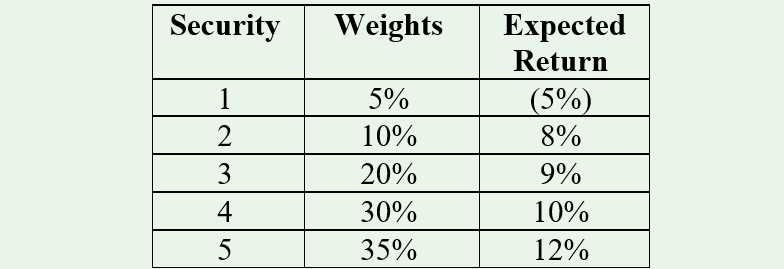14.18: Chapters 12-14- Review Questions
- Page ID
- 88660
1. How are the Return to the Investor and Cost to the Issuer related?
2. What is the cost of debt? Are taxes included? What is the relevant formula?
3. What is meant by “Technical Default”?
4. What are the two elements in the Cost of (Common) Equity Capital?
5. The investors’ “Required Return on Equity” (RM) consists of what elements?
6. What is meant by “Market Risk Premium”?
7. What is meant by “Portfolio Risk Premium”?
8. What is meant by “Rational Expectations”?
9. Define each of the following Risks:
- Liquidity
- Credit
- Inflation
- Sovereign / Country / Political
- Foreign Currency
With respect to Inflation Risk, utilize the phrases “Nominal” and Real” properly.
10. How are Price and Reinvestment Risks related? Explain.
11. Who are the two major credit rating agencies?
12. Do the agencies agree with one another on all ratings? Explain.
13. What is the difference between “Investment Grade” and “High-yield”?
14. How do credit ratings relate to default risk?
15. To what do “Indenture” and “Covenants” refer?
16. What is a “lien”? What relevance does it have to bonds?
17. What two variables are depicted on the “Yield Curve,” and on what axes are they depicted?
18. If the bond category is not stated on the Yield Curve, what is the default option?
19. Define “Liquidity Preference.” What impact does this concept have on the “normal” slope of the Yield Curve?
20. What is meant by an “Inverted” Yield Curve? Why does it come about? How long does it usually last?
21. Discuss each of the four Yield Curve theories.
22. Observed rates are stated below. Fill in the Spot Rates. Graph it.

23. Draw in a fictitious Yield Curve for Treasuries of your liking. Then, draw in a B-rated Corporate Bond Yield Curve. Posit a Credit Spread for the Ten-year bonds.
24. Using the graph you drew in the prior question, show how Credit Spreads may expand or contract.
25. Why do Credit Spreads expand and contract?
26. What is meant by a “Flight to Quality”?
27. Define the three forms of income. To which financial instruments does each refer?
28. Explain the “Valuation Premise.”
29. Calculate the “Holding Period Return” (HPR), given the following:
- Initial cost: $12 million
- Income over holding period: $1.3 million
- Sale Price: $11 million
30. What is the key deficiency of the HPR?
31. Define each of the following. Can you find another name for each?
- Face Value
- Coupon
- Market Yield
32. What is meant by “Par, Discount. and Premium”? Why are bonds priced one or the other of these ways?
33. Given the following, calculate the price of this bond? Your answer should be stated in percentage terms.
- Coupon: 4%
- Term-to-maturity: 10 Years
- Discounting Frequency: Semi-annual
- Yield-to-maturity: 8%
34. What would be the price for the bond in the prior question if its coupon were 0%? Explain in words why the price is higher or lower.
35. Why does compounding frequency matter in pricing bonds?
36. What two variables determine a bond’s market yield? Explain your terms.
37. Why may it be said that the “true” price of a bond is its Market Yield and not its dollar price?
38. Is it reasonable to ascribe the Valuation Premise to equities, or just to bonds? Why?
39. Define each of the following terms relative to equity valuation:
- Going-concern Value
- Liquidation Value
- Book Value
- Market Value
- Intrinsic Value
- Relative Value
40. Why are equities so important to our Macroeconomy?
41. Given the following, calculate the stock’s Intrinsic Value, and its current and prospective Dividend Yield.
- Last Dividend = $3.20
- Discount Rate = 8%
- Growth Rate = 3.5%
42. In addition to a mathematical explanation, why must a stock’s discount rate exceed its dividend growth rate?
43. What categories of equity are best suited to the no-growth and constant growth Dividend Discount Models (DDM)?
44. Does it matter that the DDM is based on yearly dividends when stocks pay dividends quarterly? Explain.
45. You are given the following. Calculate the stock’s dividend growth rate.
- Common Equity = $100 million
- Return on Equity = 10%
- Number of Common Shares Outstanding = 5 million
- Payout Ratio = 20%
46. If the Equity Discount Rate in the prior question is 10%, what is the Intrinsic Value of the stock?
47. What will be next year’s price for this stock?
48. Explain each of the three variables that determine the Equity Discount Rate.
49. What is the relationship between the growth rates of the dividends and the price of the stock? Explain.
50. Given the following data, what is the expected portfolio return? (Note the signs.)

51. Following are the annual returns for Joseph’s portfolio for the last five years.
a. What are his arithmetic and annualized geometric returns?
b. Does it matter that the data are not ordered chronologically?
c. Why are the two measures related as such, i.e., where one is higher than the other? Which calculation is more conceptually accurate?

Solution to Question #22:

A = 1r1 = 2.0%
B = 2r1 = (1.02) (1 + B) = 1.0252
C = 3r1 = (1.02) (1.030024) (1 + C) = 1.03253
D = 4r1 = (1.02) (1.030024) (1.047687) (1 + D) = 1.044
E = 5r1 = (1.02) (1.030024) (1.047687) (1.062827) (1 + E) = 1.03755


